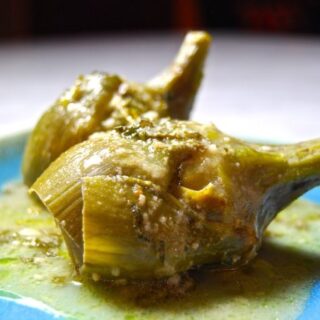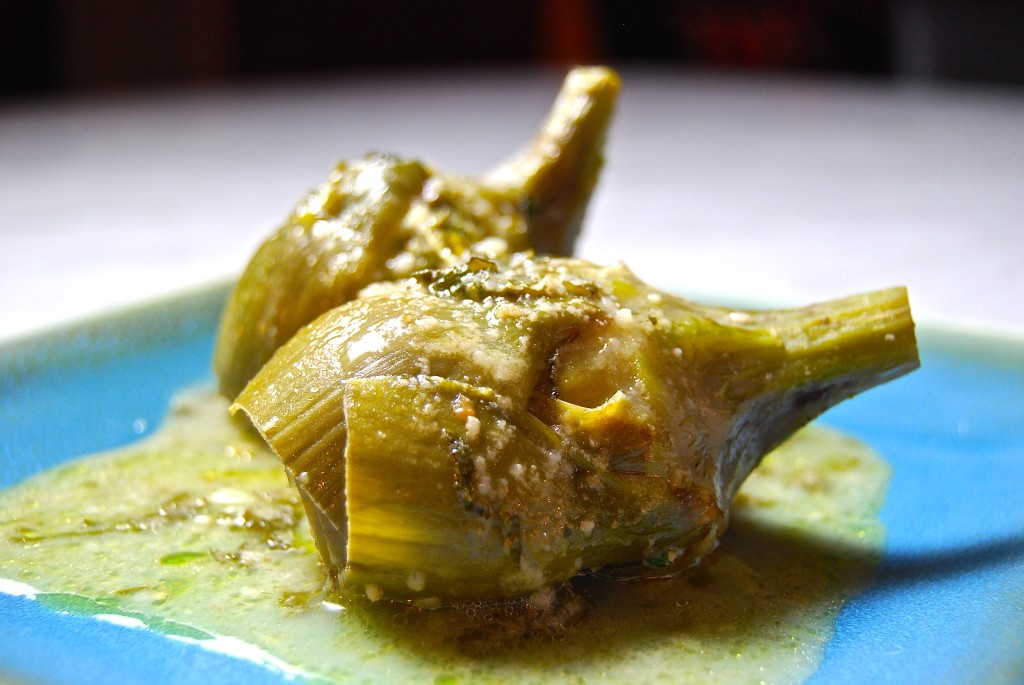Carciofi alla Romana – Roman-style Artichokes
Few vegetables are as revered in Roman cuisine as the artichoke. Late February marks the start of the artichoke season in Rome, and the lovely thistle vegetable makes its appearance in fruit and vegetable markets and on menus across the city.
The variety of artichoke found around Rome and throughout the region of Lazio is called the Romanesco, notable for its green and purple hues. It is more tender than the artichokes we find here in the States, but we make due with what we can find.
In Rome, artichokes are prepared in one of two ways: alla giudia, or Jewish-style; and alla romana, Roman-style. In carciofi alla giudia, the artichoke is deep fried to a savory crispness. Too cumbersome to make at home, carciofi alla giudia are on the menu of every Roman trattoria, especially those found in the historical Jewish Ghetto neighborhood. It’s a must-try when you are in Rome.
An easier recipe to prepare at home is carciofi alla romana. In this recipe, the artichokes are cleaned, stuffed with a mixture of garlic, parsley, mint and breadcrumbs, and then braised in olive oil and water until tender. Intended as a side dish, these roman-style artichokes steal the show every time.
A local wine, like a Frascati from Principe Pallavicini, pairs well with this regional artichoke dish without overpowering its nuanced flavors.

Carciofi alla Romana - Roman-style Artichokes
Few vegetables are as revered in Roman cuisine as the artichoke. In this recipe, the artichokes are cleaned, stuffed with a mixture of garlic, parsley, mint and breadcrumbs, and then braised in olive oil and water until tender.
Ingredients
- globe artichokes4
- Juice of 1 lemon
- 2 Tbsp mint, chopped
- 2 Tbsp Italian parsley, chopped
- 50 grams bread crumbs
- 100 ml extra-virgin olive oil
- Salt
Instructions
Clean the artichokes by removing the tough, outer leaves until you get to the tender part. Look for the soft, yellow coloring at the base of each leaf.
Slice off the top 1/3 of the artichoke.
Open the artichoke and remove the choke, or the fuzzy white part inside.
Chop off the longest part of the stem, leaving about 5cm (2 inches) of it. Use a paring knofe to clean the remaining step by stripping away its outer layers.
Squeeze the juice of one lemon into a bowl of cold water (the lemon keeds the artichokes from turning brown), and let the artichokes bathe.
In the meanwhile, chop the garlic, mint and parsley. Mix the garlic and herbs together with the breadcrumbs and a pinch of salt. Add just enough olive oil to form a paste.
Remove the artichokes from the water. Using a small spoon, stuff the breadcrumb mixture into the center of each artichoke.
Salt the outside of the artichokes. Place each artichoke head down into a saucepan. Pour the olive oil over them, and let them cook for a few minutes over medium heat. Add water until the artichoke bulbs are half-submerged.
Cover, and cook over medium heat for approximately 30 minutes. Check them for tenderness by piercing them with a fork. Allow them to cook a little longer if necessary.
Notes
Serve your carciofi alla romana with a little of the cooking liquid spooned over them.



ninivepisces
I hope I will harvest some artichokes from my plants this year… then I will try this out!
Adri
How beautiful! I was in the market the other day and when I saw the artichokes. I always like it when they come in bringing their promise of Spring. What a lovingly written article, come sempre. Complimenti!
domenicacooks
Really nice how-to post, Due. Thanks for sharing. I so wish we had good artichokes around these parts. When we do find them they are prohibitively expensive (as in $4 apiece!). My mother made carciofi alla romana and sometimes that was our main course. She didn’t remove the outer leaves except for a very few on the bottom. Instead, she would stuff filling between the leaves and then cook them for a long time in a braising liquid of olive oil, water and wine. We would pull out the leaves and scrape off the stuffing with our teeth and then discard the leaves. The prize, of course, was the hidden artichoke bottom. Yours look so good I could probably demolish them in one bite.
Phyllis @ Oracibo
I am not the least bit jealous! It’s torture waiting til we get to Rome…sure hope they save us some! I plan on having them every day! Alla Guida is amazing, sprinkled with a bit of salt…I can taste it now!
PolaM
Every time I see artichokes here my heart sinks a bit: why couldn’t they pick them just a little sooner? they are obviously too old! But you managed to make them awesome!
Simona
You make my mouth water more than usual, as artichokes are one of my favorite vegetables. I have tried a few times to cook our local artichokes: they look beautiful, but they don’t taste like the romanesco I grew up eating. And you are right: their tenderness! Sigh.